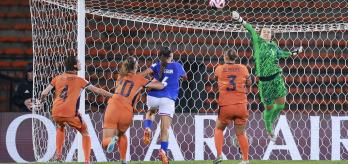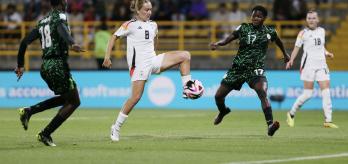During the Women’s Olympic Football Tournament Paris 2024 (WOFT24), it was reported that centre-backs were having an increased impact on their team’s ability to break lines compared to FIFA Women’s World Cup Australia & New Zealand 2023™, with notable increases acknowledged in their forward passing/line-breaking success rates. A key function of FIFA’s Technical Study Group (TSG) is to assess the relevance of ‘trends’ at different levels of the game, so it was interesting to note how the trend observed during the WOFT24 has also been recorded during the FIFA U-20 Women’s World Cup Colombia 2024™ when compared to the FIFA U-20 Women’s World Cup Costa Rica 2022™.
Our data confirms that centre-backs completed nine more forward passes per 30 minutes in possession (P30IP), recording 63 forward passes P30IP in 2022 compared to 72 P30IP in 2024. Their success rates for forward passes attempted have also improved by 5% from 75% in 2022 to 80% in 2024.
Interestingly, ball carries, ball progressions and step-ins attempted/completed were all slightly down compared to in 2022, so it demonstrates that centre-backs are also showing a greater willingness to choose a forward passing option to progress the ball rather than stepping in or carrying the ball forward.
According to TSG member Anna Signeul, “The women’s game is evolving, and players are developing to a very high level technically. In this tournament we saw that centre-backs could complete successful forward passes when under pressure, so we are now also seeing a trend whereby, when opposition teams drop into mid and low blocks, leaving these centre-backs in possession under no pressure, those centre-backs are breaking lines and completing forward passes with success rates that we have not seen in the women’s game previously. This is very interesting because the question must be asked if it is tactically wise, to leave players who are now so competent at playing the ball forward in possession, under no pressure?
“And it is not just a certain type of forward pass. They are successfully executing a variety of line-breaking passes and doing so based on their assessment of where the space and opportunity is. These players can play into and onto their team-mates, showing an ability to break lines by going around, through and over the opposition’s defensive lines. We are dealing with players who are fit, game intelligent and technically superb, and the game is changing as a result of that. They are in full-time academies earlier and this is showing in the quality they are displaying on the pitch,” she added.
FORWARD PASSES
When we explored the success rates of centre-backs on an individual basis per 60 minutes ball-in-play time (P60BIP), some of the numbers were even more impressive, with nine players completing 90% or more of their attempted forward passes in this metric. In addition, we can see in the second graphic below that the volume of forward passes completed per 60 minutes ball-in-play time is also significant, with the top ten ranked centre-backs all completing a minimum of 46 successful forward passes P60BIP.
Our TSG has selected examples of some of the impactful line-breaking passes executed by centre-backs during this competition.
Germany’s centre-back pairing of Vanessa Diehm (5) and Jella Veit (4) were very effective for their team, with Diehm completing 91% of her forward passes attempted and 80% of her forward passes under pressure which was a total of 86. Veit completed 66 forward passes under pressure, with a 69% success rate. In clip 1 below, we see a possession sequence where both centre-backs complete unopposed line-breaking forward passes through and over Venezuela’s defensive structure.
In clip 2, the USA’s centre-back, Jordyn Bugg (4), completes a forward pass into Maddie Dahlien (17), breaking two of Paraguay’s defensive lines. She is unopposed as her team builds up from a goal kick. Bugg completed 90% of her attempted forward passes during this tournament.
And in clip 3, playing in a back three, Spain’s left centre-back, Silvia Lloris (8) completes a stunning forward pass that breaks all three lines of Paraguay’s defence in a possession sequence that leads to a goal. She was the top-ranked centre-back for completed attacking line breaks with 13.0 per 60 minutes ball-in-play time.
Step-ins/line-breaking passes
While centre-backs attempted fewer line breaks with ball carries/step-ins compared to 2022, they still proved effective when they did perform these actions. Here, our TSG highlights some examples of the proficiency levels of centre-backs who broke lines with ball carries or step-ins prior to executing a successful forward pass.
In clip 4 below, Brazil’s centre-back, Rebeca (5), steps in between Canada’s two centre-forwards, breaking the first line of their defence. She then plays a successful diagonal, forward pass into the wide channel in a possession sequence that leads to an attempt at goal. Rebeca completed 80.6% of all her line-break attempts when under pressure (including step-ins, ball carries and forward passes).
Clip 5 is from the FIFA U-20 Women’s World Cup 2024 final, as Japan’s right centre-back, Uno Shiragaki (17), breaks the first line of Korea DPR’s defence with a successful ball carry before completing a forward pass. She completed 92.1% of all attempted line breaks under pressure.
Finally, in clip 6, Mexico centre-back Ana Mendoza (3) performs a line-breaking step-in against the USA, followed by a successful forward pass. Mendoza was the highest-ranked player in the tournament for ball progressions/step-ins with 4.4 per 60 minutes ball-in-play time, (2.1 more than any other player). She was also the tournament’s second-ranked centre-back for completed attacking line breaks with 10.7 (P60BIP), with only Spain’s Lloris ahead of her.
Key take-aways
Here is a summary of our TSG’s findings regarding the role of centre-backs in possession during the FIFA U-20 Women’s World Cup Colombia 2024:
- In possession, centre-backs have better technique on the ball when opposed and unopposed
- Centre-backs breaking opposition lines with forward passes more often in Colombia 2024, compared to Costa Rica 2022
- Variety of passing (into, onto, around, through and over) to break opposition defensive lines
- Defending teams dropping off in mid/low blocks leaving technically competent opposition centre-backs unopposed in possession
- Centre-backs attempting fewer line breaks with ball carries/step-ins compared to 2022 but are successful when performing them
- Will this trend force teams to press higher?





































